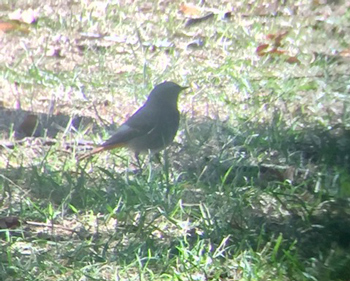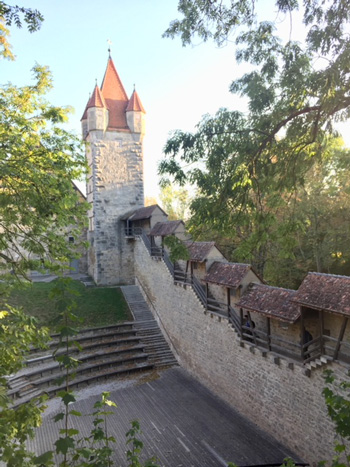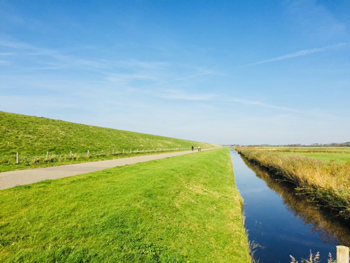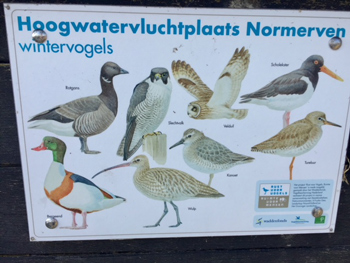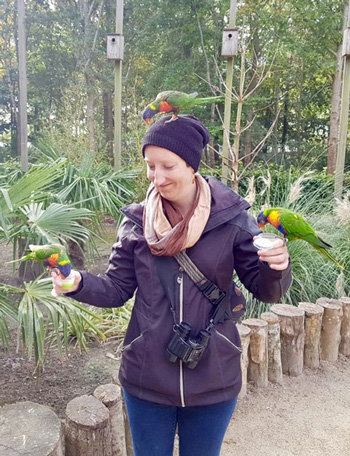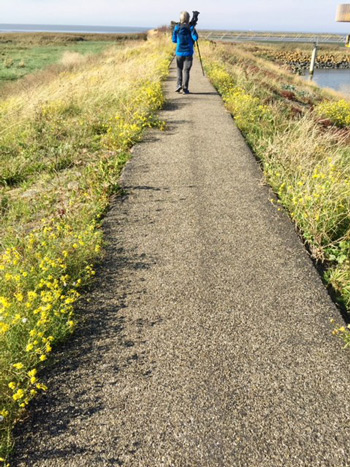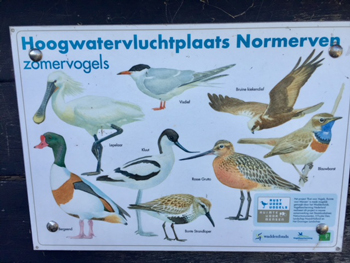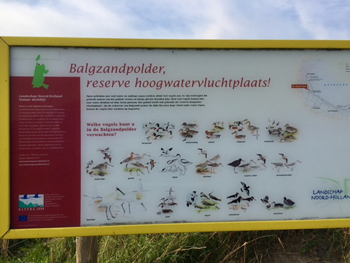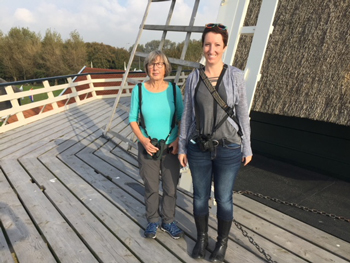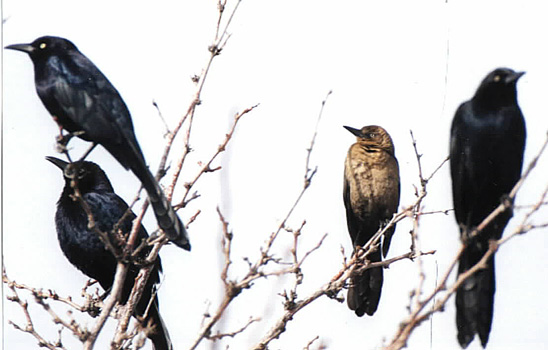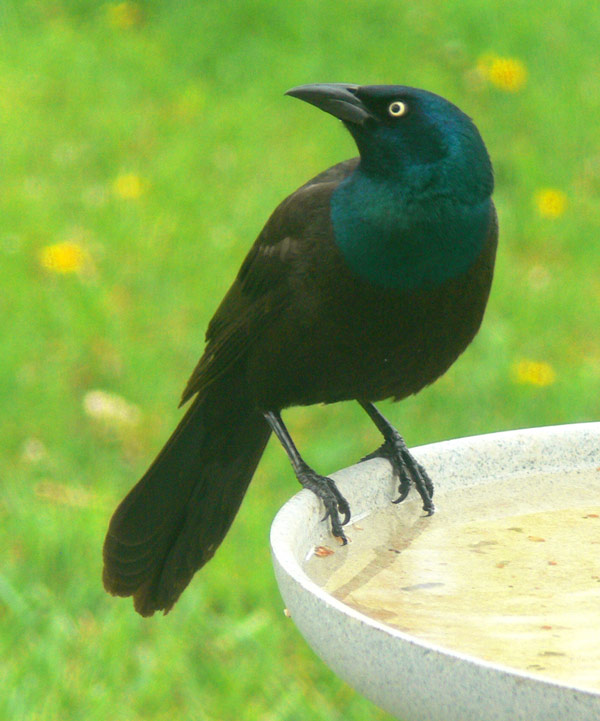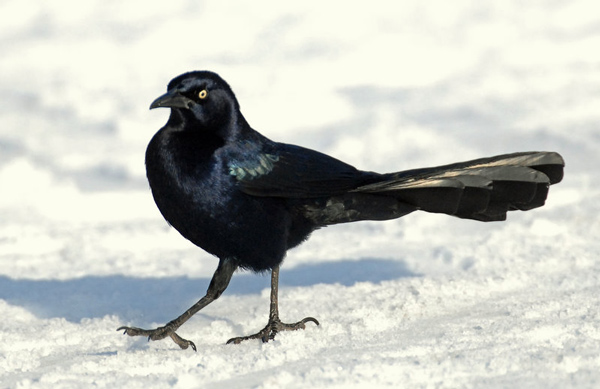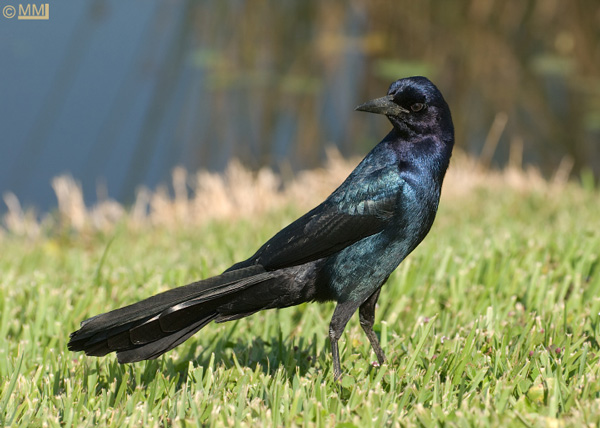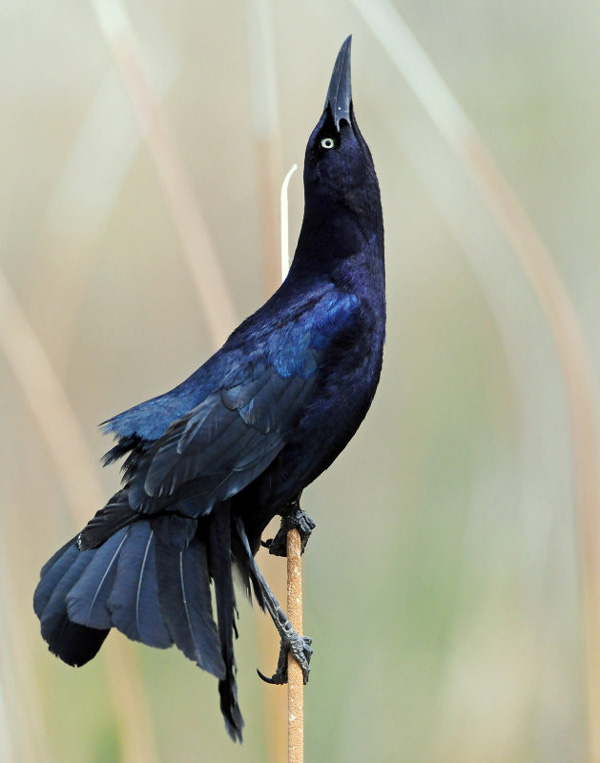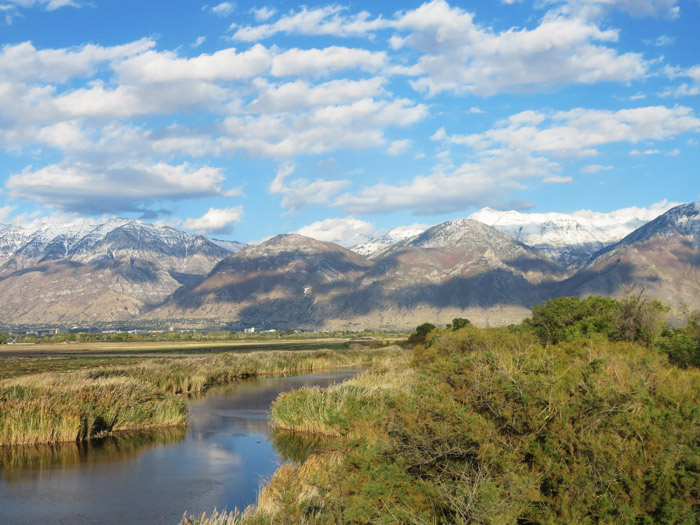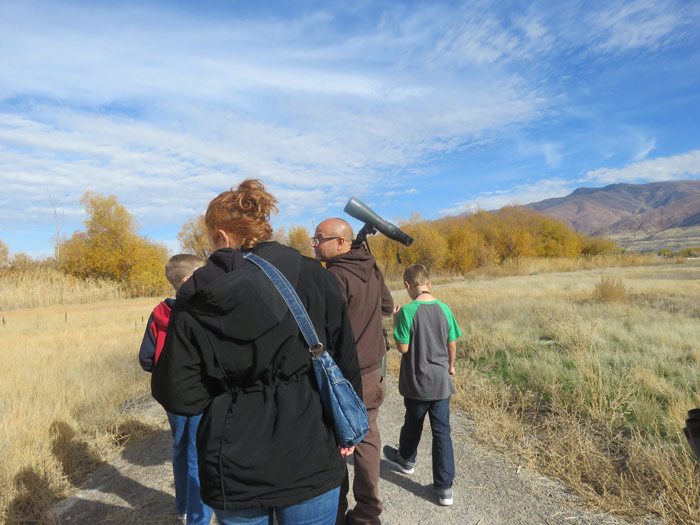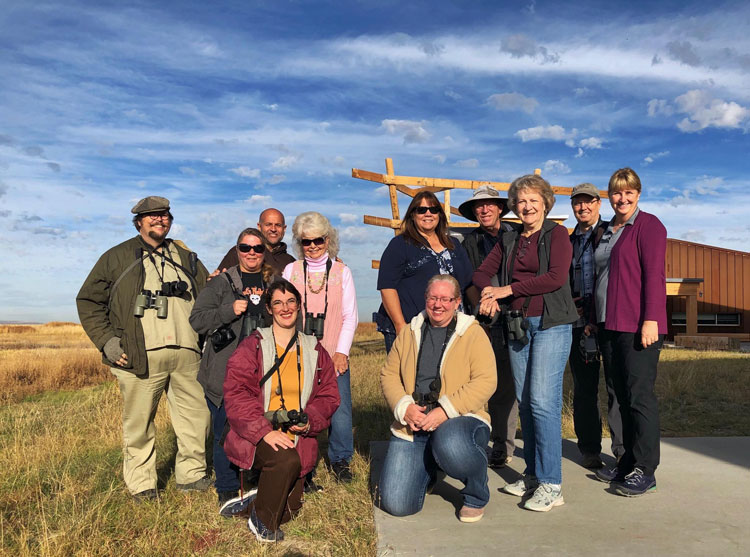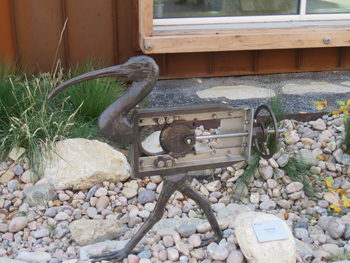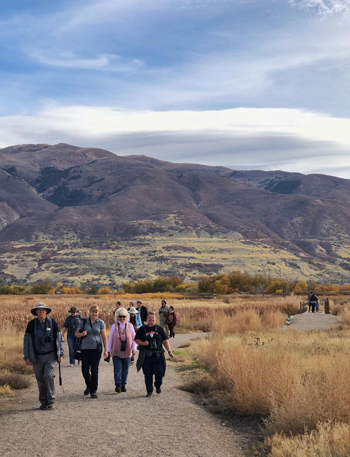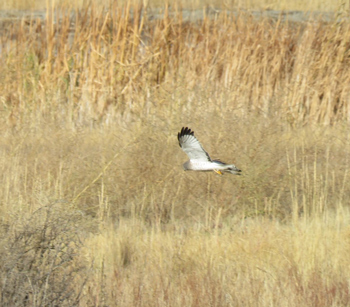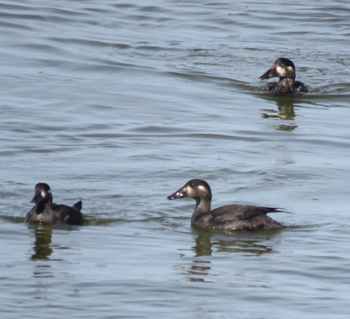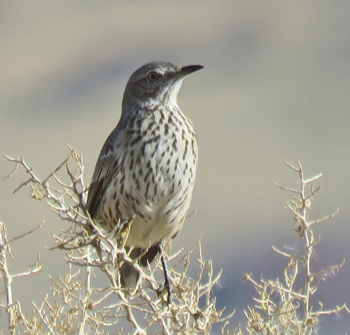Utah County Birders
Newsletter
|
||||||||||||||||||||||||||||||||||||||||||
 |
Contents
Monthly Meeting
Upcoming Field Trips
Captain's Log
Bird of the Month
Field Trip Reports
Thursday, November 8, 2018, 7:00 PM at the Bean Museum on BYU Campus - Map to Museum
Show and Tell. We don't have a guest
speaker this month, but let's plan on meeting at 7 for a little show and tell.
If you have pictures or bird stories you'd like to share, bird IDs you'd like
some help with, info about birding trip plans, etc... let's get together and
share them.
Fall migration in ST.GEORGE!!!
Friday November 2nd, meet at 6:30 am at McDonald's on Bluff street. -chasing rarities with Kendall Watkins.
Saturday November 3rd, meet at 6:30 am at the McDonald's on Bluff street. We will be birding at Lytle ranch!!!
We are actively recruiting people to lead local half-day field trips, any time, any place. If you would like to lead a field trip or if you have any ideas for this year’s field trips, please contact Suzi Holt at - suzerqholt@gmail.com
Utah County Birders
Captain’s Log: November
2018
by Keeli Marvel
|
Birding in Europe Part
Two: Germany and the Netherlands
Has a month gone by already? I can't believe how fast it went!
Last month I told you about
birding in Ireland. This month I'll finish off my trip report
with Germany and the Netherlands.
After spending a week in Ireland, my mom and I parted ways and I headed to the Netherlands to meet up with my old friend Cami and her family who live in North Holland. They go to Stuttgart, Germany every year for the Oktoberfest festival and had invited me along for the ride. The entire next day was spent driving to Stuttgart from the Netherlands. While driving 100mph on the Autobahn doesn't exactly lend itself to birding, I did see lots of raptors, most of which were likely Common Buzzards, a species similar to our Red-tailed Hawks.
Stuttgart is a large city
full of people so the birds were few and far between, but I did
see and hear several Great Tits in the trees around town.
They seem to be very adapted to city life.
After a couple of days in
Stuttgart we hit the road and headed to Rothenburg ob der Tauber,
a beautiful walled town that looks like a quaint little Christmas
Village. There's a walking path along the wall that is great for
birding, a large park just outside the wall, and the town is
surrounded by beautiful forested hillsides. While wandering around
town, we paused for a few minutes in a little park near the church
called Frankenhöhe
Nature Park and I picked up a lifer Black Redstart as well
as more Blue Tits, Great Tits and a Common
Chaffinch. I could hear some birds singing loudly from a
rooftop around dusk that evening, and I later confirmed those to
also be more Black Redstarts. Jackdaws were also common in
Rothenburg and large flocks of them roosted on the church and
along the rooftops of the city within the wall.
On our drive back through Germany, Belgium, and into the Netherlands I didn't have much opportunity to stop and bird, however, I did manage to spot a lifer Black Kite. Kites in Europe are large raptors which have a very characteristic shape. They have long slender wings and a unique forked tail that helped me instantly recognize the one I saw soaring as a member of the Kite family. |
]
|
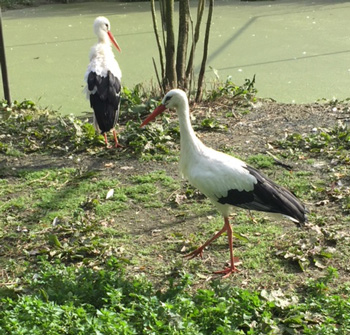 Storks at the zoo in the Netherlands My last few days in the Netherlands were a real treat for birding. My friend Cami lined me up with a local birder named Truus who generously offered to pick me up in her car and take me birding. We spend an entire day and the evening of the next day birding around North Holland and around the west coast of the Netherlands. Our first stop was a place called Twisk, an open grassy area with walking paths along canals with little raised hills that looked out over a pond with mudflats and an island that was perfect for wading birds. At Twisk I picked up adorable lifer Bearded Reedlings in the reeds along the pond, by far my most favorite bird of the trip. I also picked up lifer Barnacle Geese, Bar-tailed Godwit, Common Snipe, and Meadow Pipits. There were other birders at Twisk chasing a rare bird alert - a Pectoral Sandpiper had been spotted there and birders were flocking in to see it. As Truus already had it on her list, and I had plenty of opportunity to see them here at home, we continued on our birding adventure. In a marshy area called Dijkwielen along the coast near Den Oever I picked up a heard-only lifer Water Rail., and then further west along the coast we climbed up the dike wall and scoped out the shoreline and I picked up a lifer Spotted Redshank amongst hundreds of Eurasian Curlews, godwits, Common Redshanks, Eurasian Oystercactchers, Common Shelduck, European Golden-plover, and Dunlin. In Den Oever we had a fantastic fresh seafood lunch and a nice afternoon walk along a dike along the harbor.
The following evening we went back
out to the coast at high tide to try and round up a few more species. Our
first stop was at a wildlife refuge area called Balgzandpolder where we
peered through bird blinds at a lake surrounded by geese and wading birds.
I picked up a lifer Common Greenshank and got great
looks at several more Common Snipe feeding amongst
the Northern Lapwings, gulls, geese, and ducks. I also addedEurasian
Kestrel to my life list. I'd seen them before while driving through
the Netherlands and Germany, but never managed to get one recorded into
eBird. A couple miles further up the coast we pulled up to a dock right on
the ocean, and I added a pair of lifer Common Eiders, ocean
ducks that usually don't come in that close to shore, but which were
likely brought in by the high tide. They which were keeping company with
Black-headed and Great Black-backed Gulls. As the sun was setting on my
last evening in the Netherlands, we made one more stop along the coast
near a town called Westerland where we sifted through hundreds of Eurasian
Curlew, Dunlin, Black-bellied Plover (which they call Grey or
Silver Plover), and the occasional Common Ringed-Plover to find
one last lifer, a Black-tailed Godwit, bringing my
total lifer count for the trip to 30 species!
Thanks for sticking with me through the travelogue. As we head into the holiday season I hope you all have a fabulous Thanksgiving! In the blink of an eye November will be gone and it'll be December, and you know what that means?! Christmas Bird Count Time! Hope to see you all out and about! Happy Birding!
Keeli Marvel
|
|
|
Great-tailed Grackle, Quiscalus mexicanus
What was the last bird you saw in a parking lot? Yes, in this country we see gulls, but what about the other birds? Let’s name our common regional parking lot cleanup crew: Crows, Ravens, European Starlings, Magpies, English Sparrows and Grackles. This month, I would like to introduce you to the latter, the grackle. Specifically the Great-tailed Grackle, Quiscalus mexicanus. It is a medium-sized, highly social passerine, or perching bird, native to Central and South America. These Icterids, like other birds of opportunity, have moved north following the availability of food. I first saw a flock of great tailed grackles on a birding trip to Box Elder County. We stopped at the Walmart parking lot in Brigham City. Dick Hurren took a cup of cat food and tossed it out in front of our parked cars, then we watched as the grackles flew in to clean up the free food. We joked at the time that grackles seem to “show up” at new Walmart stores.
So how do we know what we are seeing? Three of eight grackle species are native in the US, the Boat-tailed Grackle and the Common Grackle are found mostly east of the Rockies. The Mexican or Great-tailed Grackles have become the most common in the west. However, both the Great tailed and common Grackles can be seen, at times, in Utah state and county. Jonathan Adlerfer in the National Geographic Complete Birds of North America describes three great-tailed grackle subspecies, prosopidicola(Texas-east), monsoni(Arizona-Texas) and the smaller nelson(Arizona-California). All are said to be moving north. You can tell the difference between grackles in size and color: Grackles are between a robin and a crow. They are about the same length as American crows, but they are much lighter. Common Grackles have long tails, but shorter than their great-tailed cousins. Their colors are also more varied. Female common grackles don’t vary that much from their male counterparts. However male Great-tailed Grackles are iridescent black with yellow piercing eyes, black bills and legs. Females are dark brown above, paler below, with a buff-colored throat and a stripe above the eye. Juveniles have the female’s dark brown plumage, with streaked underparts and a dark eye. Great-tailed Grackles can be seen with other blackbirds pecking for food on lawns, fields, and at marsh edges, vying for trash in urban settings, or crowding in trees and on telephone lines in noisy roosts. However, they rise above the others in their intelligence. Grackles adapt their behavior with experience and habitat. Did I say they are smart? Grackles can solve Aesop's Fable tests - a problem involving a tube that is partially filled with water with a piece of food floating out of reach. The problem is solved by dropping objects, like stones, into the water to raise the level and bring the food within reach. Another way to identify a Great-tailed Grackle is with location. They are found in rural and developed areas of the Midwest and West, foraging in fields, feedlots, golf courses, cemeteries, parks, neighborhood lawns and, as we see here, big box store parking lots where food is dropped or discarded. Trees and vegetation edging water provide roosting and breeding sites where they declare their territory with song. Great-tailed grackles have an unusually large repertoire of vocalizations that are used year-round. Males use a wider variety, while females engage mostly in "chatter". However there are reports of females performing the "territorial song." Because they are loud, and great numbers can leave great deposits of manure, great-tailed grackles are often considered pests
We can hear two of Kevin Colver’s recordings curated at the University of
Utah Western Soundscape Library at the Marriott Library: Great-tailed grackles communally roost in trees or wetland reeds at night and during the breeding season they nest in territories. Territorial (Alpha) males are heavier and have longer tails than non-territorial males. This helps them defend their territory within which many females place their nests and raise young. Thus, territorial males are associated with having more offspring, while residential males live in the larger colony but do not defend a territory or have mates. Next time you are in a big-box parking lot, waiting for fellow birders to show up, look at the cleanup birds, listen to their calls and look at their size. Even though the parking lot would likely not be the most exciting place for a big year, you will be able to recognize males and female Great-tailed Grackles foraging below the trees and anywhere someone has dropped food.
References & Additional Reading: Webb, Merrill, Great-tailed Grackle, UtahBirds.org The Great Tailed Grackle, AllAboutBirds, The Cornell Lab of Ornithology Great-Tailed Grackle, National Geographic Sibley, David Allen, Great –tailed Grackle, Sibley Field Guild to Birds of Western North America, p. 443, 2003
Jaramillo, Alvaro, Blackbirds, Orioles, and Allies,
The Sibley Guide to Alderfer, Jonathan, Great-tailed Grackle, Complete Birds of North America, p. 617, 1st ed, 2006, The National Geographic Society, (2nd ed.) |
|
|
|||||||||||||||||||
|
Eccles Wildlife Education Center by Suzi Holt
|
|||||||||||||||||||
